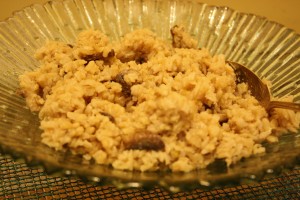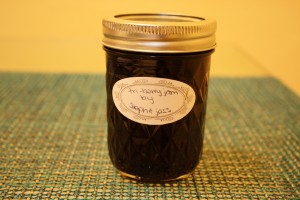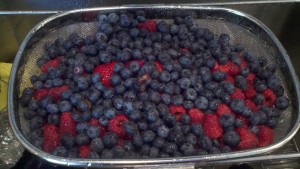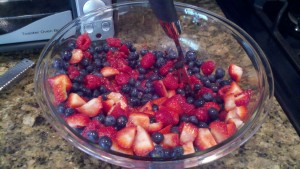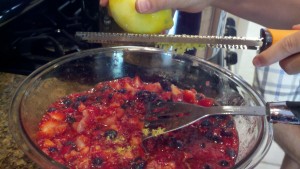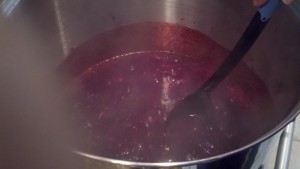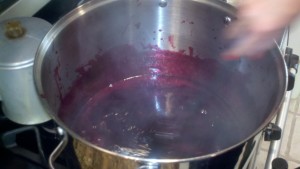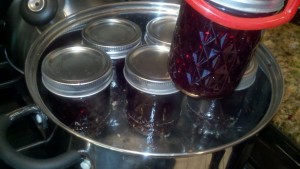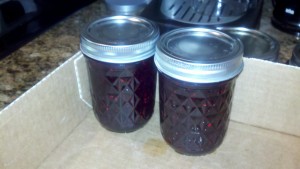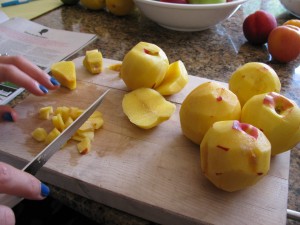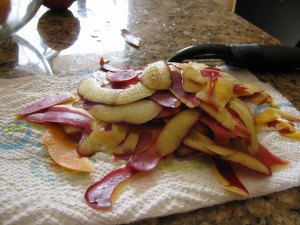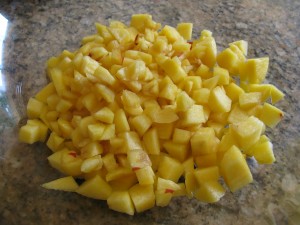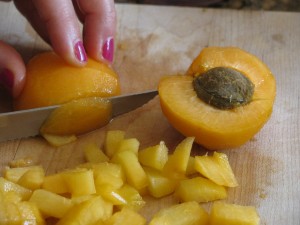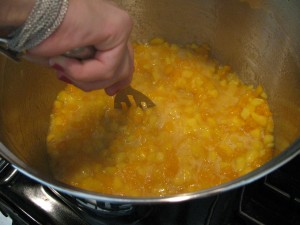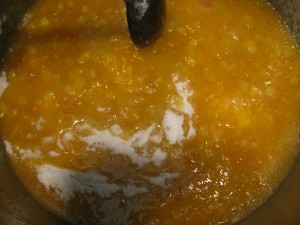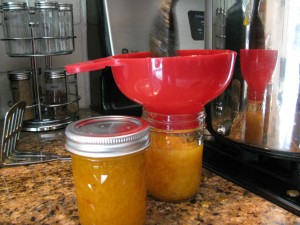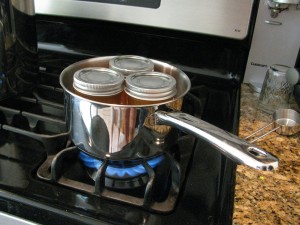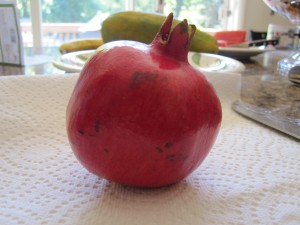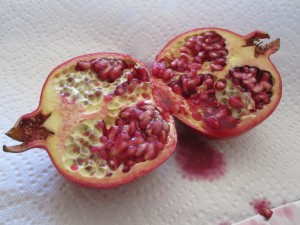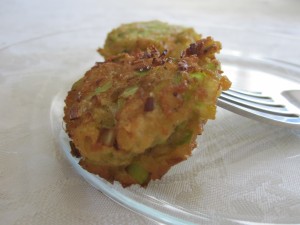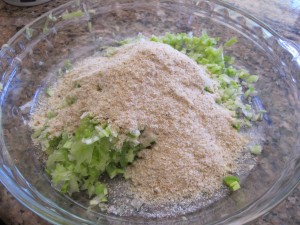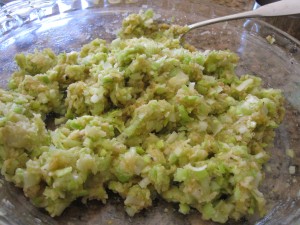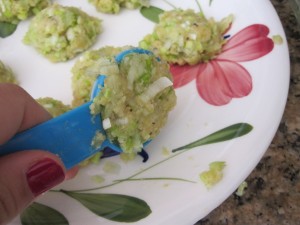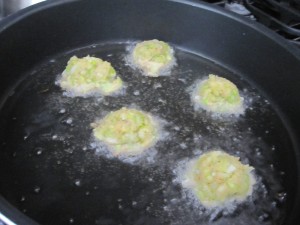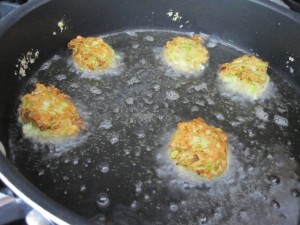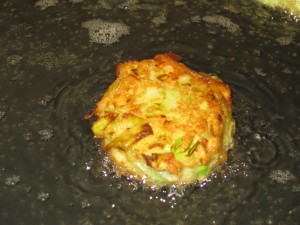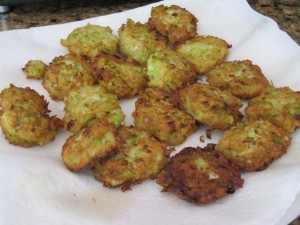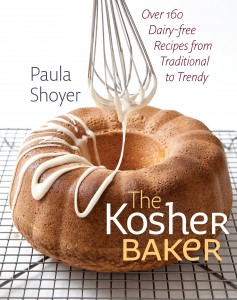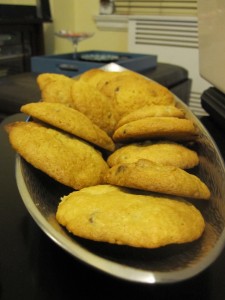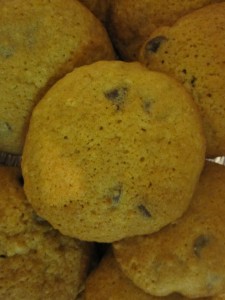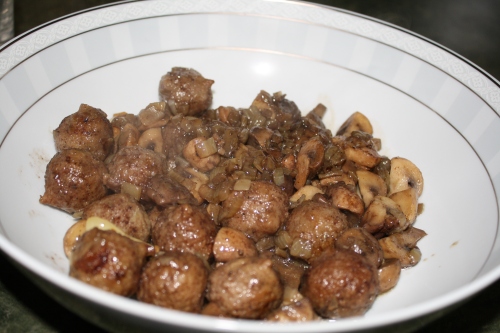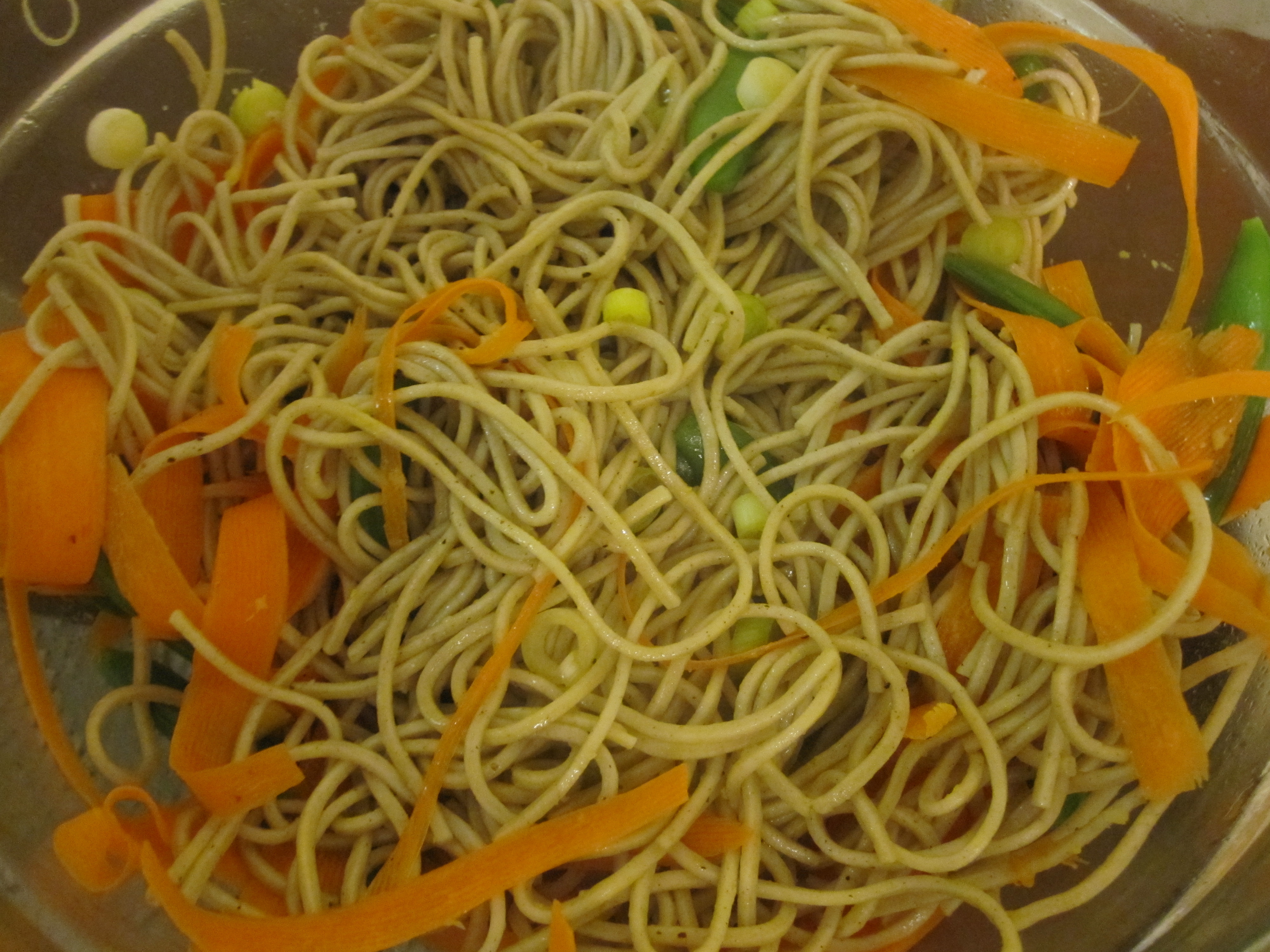A version of this dish is a staple in my mother-in-law’s kitchen. When we go there for barbecue on Sunday nights, we always have this delicious mushroom-y rice that she made using leftover Shabbat rice (Syrians make a lot of rice). I decided to duplicate this dish in a non-leftovers way and used brown rice to make it a little healthier. You can try it with your favorite kind of rice. Continue reading
Triple Berry Jam
Summer’s coming to an end, so stock up on your berries and preserve them any way you could. Our favorite way to do this is to make jam. Though freezing is probably easier, cooking and preserving the berries is a very flavorful way to enjoy our summer produce all year long. It also makes a really nice gift!
(Berries actually freeze quite well. Make sure to clean and dry them, and then store them in a zip top bag. Make sure to suck all the air out and seal it tight so that the berries don’t get freezer burned. If you want to freeze strawberries, hull them before freezing.)
Last year we made raspberry jam with raspberries we picked ourselves from a local farm. We also made strawberry-fig jam, inspired by my backyard fig tree. This summer we decided to make more mixed fruit jams, and the apricot-nectarine turned out really orange and delicious. This raspberry-strawberry-blueberry jam is an amazing deep purplish pink color. We can’t decide if it tastes better than it looks or looks better than it tastes.
Oh, we took all the photos with my new(ish) Droid-X. Pretty cool, huh?
All jam making directions and tips are from pickyourown.org and the package of pectin.
Ingredients:
- 10 cups of unprepared berries, we used 2 pints of blueberries, 1 1/2 pints of strawberries, and 3 (1-cup) packages of raspberries (when you mash these, you’ll have about 6 cups of fruit)
- Juice and zest of two lemons
- 6 cups white sugar
- 1 package Sure Jell pectin (the yellow package)
Equipment:
- 1 large pot
- 2 large bowls (one for berries, one for sugar)
- Measuring cups
- 1 large pot
- Potato masher
- Mixing spoon
- Cup of ice water and teaspoon (to test jam)
For canning:
- Mason jars with tops and rings
- Canning funnel
- Magnetic lid lifter
- Jar tongs
- Small pot for boiling the lids
- Pot for boiling prepared jars
- Dishwasher or large pot for sterilizing jars
Instructions:
If you are canning, make sure to sterilize the jars. If using a dishwasher, run it without soap. If using a pot, fill the pot with water and the jars and boil. Do not touch the inside of the jars (that’s why you have the jar tongs), because that will introduce bacteria to the sterilized jars and could result in icky jam! Do this now so it will be ready when you are. Boil the lids, too.
1. Wash the fruit. Sort through it to make sure you have no bad berries or stems, etc.
2. Chop the strawberries.
3. Add the fruit to a bowl and make sure you have 10 cups. Mash.
4. Measure out the sugar. Set aside 1/4 cup of sugar and mix with the pectin. This will allow the pectin to incorporate into the fruit better, and make sure you don’t have lumpy jam.
5. Add fruit to large pot and cook over high heat, stirring constantly. When it comes to a full rolling boiling, meaning it doesn’t stop bubbling even when you stir, time one minute. Add the pectin and stir until it dissolves.
6. While still stirring, add the sugar, a cupful at a time, until it is all incorporated.
7. Continue stirring constantly until the mixture comes to a rolling boil again. After one minute, test the jam to make sure it sets.
8. Take a spoonful of jam and dip it in a cup of ice water. If it gels, it’s ready to be jarred. If not, boil for another minute and test again.
9. Use a ladle or big spoon to fill the sterilized jars. Leave about 1/2 inch of space at the top.
10. Use the magnetic lid lifter to cover, making sure to clean the jars before placing the tops on. Screw on the lid.
11. After all the jam is canned, place in about 2 inches of water and boil for 5 minutes (or more, depending on altitude). You will hear the tops POP, either while they are boiling or after when they are cooling. If you don’t hear the pop after a while, try boiling again or just put the jam in the fridge and use it right away. It will still be good.
12. The boiled jars should last about a year (’til next summer).
This recipe made 10 6-oz jars of jam.
Nectarine-Apricot Jam
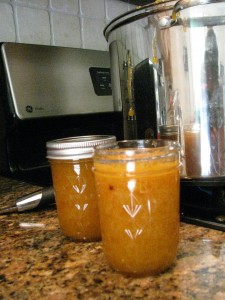 Summertime means it’s time to preserve the sweetest and best tasting fruits to enjoy during the winter months. We made this during the peak fruit season and sold them at a local bake sale (we weren’t able to attend, but we heard they sold out fast! Did you buy one? What did you think?, but we’ve neglected to share it with you until now. Sorry about that, the pictures had been hiding somewhere, but we uncovered them on Adele’s camera. (You remember Adele, right?)
Summertime means it’s time to preserve the sweetest and best tasting fruits to enjoy during the winter months. We made this during the peak fruit season and sold them at a local bake sale (we weren’t able to attend, but we heard they sold out fast! Did you buy one? What did you think?, but we’ve neglected to share it with you until now. Sorry about that, the pictures had been hiding somewhere, but we uncovered them on Adele’s camera. (You remember Adele, right?)
Ooh, so this was when I impulsively bought a bottle of blue nail polish on a trip to Duane Reade. You can see it in the corner of this picture; cool, huh:
This was our first time making jam with stone fruits, and it was a bit different than the raspberry and fig-strawberry kinds. First of all, there was a lot more chopping involved, and most importantly, it yielded a lot less jam; we only ended up with five jars.
Nectarine-Apricot Jam
Ingredients:
- 5 cups of cubed apricots
- 5 cups cubed nectarine
- 5 cups of sugar
- 1 package of pectin
Directions:
- Wash, fry, and cube the fruit.
- Sterilize the jars (we use the dishwasher, without soap) and the lids (we put them in a pot of water on the stove, but don’t let them boil).
- Cook all of the fruit in a large pot over high heat. Stir, stir, stir!
- Mix 1/4 cup of sugar with the pectin and add to the sugar. Stir some more, until the mixture comes to a boil. And then keep on stirring until you can’t stir away the boil for a whole minute!
- Add the rest of the sugar and continue stirring until it comes back to a boil. And that’s it, you’ve made jam.
- Just to make sure it jammed, test it: dip a teaspoon into the jam and then dip it into a bowl of ice water. Did it turn into a gel? If so, you’re good. If not, boil some more.
- Now you’re ready to preserve! Fill the jars with jam using a jar funnel. Use a magnetic jar top picker up-er to lift the lids and place them on top of the jars. Then screw the rings on.
- When all of your jars are filled and you’re out of jam, fill a pot with about 2 inches of water and boil the jam jars in there for 5 minutes. You’ll hear the lids pop! And now you have sterile jam. Wasn’t that fun!?
- This will keep for about a year in the pantry. Refrigerate after opening.
Leek Ejjeh + Happy New Year
Chag Sameach everyone! We hope everyone has a sweet and healthy new year.
Everyone knows the custom of dipping apples in honey for Rosh HaShanah…actually, our family has different customs (and we don’t even have honey at the table, we use sugar instead). The Sephardic custom is to make many brachot on simanim, the symbolic foods we eat during the seder, before the meal. Before sharing the Leek Ejjeh recipe with you, I thought I might explain what our holiday meal with consist of tonight, and share the simanim that we will eat in order to celebrate the new year. Some more information on a (somewhat different) Rosh HaShanah seder can be found here.
The first siman is apples dipped in sugar (or honey). We eat this so that we will have a good and sweet new year. Cut the apples and serve with a bowl of sugar. Done.
The mext is tamarim, or dates. We eat this so that our enemies may be destroyed. No need to prepare these, we just buy dried dates – medjool dates are quite tasty on their own.
The third siman is leeks. We eat these so that our enemies will be destroyed (again). The recipe for leeks is at the bottom of this post – thanks for your patience!
The fourth siman, swiss chard, is eaten in hopes of removing our enemies (yet again).
The fifth siman is gourd. We make a bracha asking God to tear up any oppressive decrees in areas where Jews live and to proclaim our merits before Him.
The next siman is black eyed peas, or Lubiyeh. We eat this in order to increase our merits. These small beans are eaten stewed with meat – our family uses kibbe (the same little meatballs I made with mushrooms the other day) – and served as part of the regular meal and the seder during the holiday meal.
We eat the next siman, pomegranates (or rimon), asking God to grant us bountiful merits and goodwill, as many as the fruit’s seeds. Cut the fruit in half and immerse in a bowl of water while scraping the seeds away from the flesh with your fingers. The white flesh will float to the top, and the seeds will sink to the bottom. Scrape the flesh from top of the bowl and drain the seeds, it’s as easy as that. This method also stops your kitchen and clothing from getting all red.
Lastly, we eat tongue as the next siman. Tongue is eaten to symbolize a lamb’s head (I think some families eat fish, as well). This is to symbolize that we will be leaders (at the head) rather than followers at the trail. The meat is also a reminder of the ram that Avraham sacrificed instead of his son, Yitzchak. We buy tongue from the deli. Most people at the table don’t want to eat it.
The last thing we eat, after the simanim, is a new fruit. This should be a fruit that has just come into season, and therefore we were unable to eat for an entire year. We say Shehechianu on this fruit and thank God for keeping us alive and bringing us to this season. Our family usually eats starfruit or dragon fruit.
And without further ado, the leek ejjeh we will be enjoying for the next two nights:
We actually make our leeks into small latkes, quite similar to the tasty Chanukah treat. They’re delicious this way – crispy, tasty, and small. Not breaded like onion rings, but with the same flavor. They taste somewhat similar, actually.
Ingredients:
- 2-3 large leeks, or 4-5 small leeks, washed well and chopped (don’t try to grate them on a box grater. They will get stringy)
- 1/2 cup breadcrumbs or matzah meal
- 2 eggs
- Egg white from one egg
- Salt and pepper
- Vegetable oil, for frying
Directions:
1. Prepare oil for frying: pour about 1/2 inch of oil into a high-walled pan. Place on burner over medium heat.
2. Combine leeks, eggs, and breadcrumbs. Mix to combine. Check consistency. If it’s too dry, add the egg white. If too wet, add more bread crumbs. The batter should be loose but be able to come together into a ball if squeezed. Add salt and pepper.
3. Using a tablespoon measure, scoop out batter into balls.
4. Test the frying oil with a tiny amount of batter. Make sure it sizzles but doesn’t burn. Prepare a plate or tray to drain the patties after frying. I used a paper towel-lined plate. My grandmother used to use brown paper bags (yes, the ones from the grocery store). Alton brown uses a cooling rack on top of a towel-lined cookie sheet. That’s probably the best idea if you can do it.
5. Using a slotted spoon, drop the batter, one at a time, into the oil, flattening into patties as you drop them. Only put 5-4 in the oil at a time, because you don’t want the temperature to drop too much and the patties to get soggy.
6. After one minute, they should be brown. Flip the patties. Fry on the other side for a minute. Remove from oil with slotted spoon and place on draining plate. Repeat until all are fried.
7. Sprinkle with salt when still warm.
8. Serve along with the bracha: “that those who hate us be cut away”
Shana tova!
Chewy Double Chocolate Chip Cookies
Paula Shoyer was generous enough to send us a copy of her new cookbook, The Kosher Baker. It’s a cookbook that consists totally of pareve desserts! Over 160 of them! And she tested them out for us already, so we don’t have to experiment with rice and almond and soy milk.
One of my favorite parts of this new cookbook? The way it’s set up. If you only have 30 minutes to whip up a dessert, turn to the front section, “Quick and Elegant Desserts:” if you’re in the mood to make a more complicated recipe, leaf through the “Multiple-Step Recipe” section. How cool is that!?
Paula also goes through a bit of kosher baking history; did you know that for dessert after meat meals people used to use fat rendered from meat and poultry instead of butter? Ew! She uses the now-readily-available butter substitutes instead, and (as you probably know already) we prefer Earth Balance.
Now, just in time for the holidays, I can bake pareve desserts for every meal! The first one I tried was (as you can probably guess from the title) chocolate chip cookies. Why? Well, we don’t have any of those on this blog! And everyone should have a chocolate chip cookies recipe, because really, you can’t go wrong with a chocolate chip cookies. Who doesn’t like them?
These specific cookies had an element that I’m not used to adding to my cookies: 1 cup of oats, ground. You could kind of taste it, but the oats play more with the texture than the taste, making them airy and light cookies, with a bit of a crunch on the outside.
Double Chocolate Chip Cookies, Reprinted with permission from The Kosher Baker by Paula Shoyer, Brandeis University Press/University Press of New England 2010
Storage: Place baked cookies into an airtight container or freezer bags and store at room temperature for up to five days or freeze up to three months.
I have given you two ways to bake these cookies: one allows you to bake them right away, and the other allows you to freeze them and bake them later in smaller batches. I usually keep rolls of dough (marked “dairy” or “parve”) in my freezer so that if I have unexpected visitors, I can just slice and bake my own cookies, which are ready to share in no time. I also like to shape the dough into logs, let them set up for 2 hours in the freezer, and slice them because the cookies all come out the same size—vestiges of my days catering when I actually sold these cookies in Geneva, Switzerland to people who wanted a taste of America
1/2 cup (1 stick) parve margarine
1/2 cup sugar
1/2 cup light brown sugar
2 large eggs
1 teaspoon pure vanilla extract
1 cups raw oats (not quick-cooking kind)
1 1/3 cups all-purpose flour
1/2 teaspoon baking powder
1/2 teaspoon baking soda
1/4 teaspoon salt
1 1/2 cups parve chocolate chips
3 1/2 ounces parve semisweet or bittersweet chocolate
1. Preheat the oven to 400°F. Line two cookie sheets with parchment.
2. In a large bowl, beat the margarine, sugar, and brown sugar with a stand or hand-held electric mixer, or by hand with a whisk, until creamy. Add the eggs and vanilla and beat until smooth.
3. Place the oats into the bowl of a food processor fitted with a metal blade. Process until the oats are ground to a powder. Add the powdered oats, flour, baking powder, baking soda, and salt to the egg and sugar mixture and mix until combined.
4. Add the chocolate chips to the batter and mix in. Using the small holes of a box grater or microplane zester, grate half of the bar of semisweet chocolate into a medium bowl or over a cutting board. Add the grated chocolate to the bowl with the dough. Place the other half of the chocolate bar in the food processor bowl that you used for the oatmeal and process until the chocolate is in very small pieces. Add the pieces and any powdered chocolate in the bowl to the cookie dough and mix just until all the chocolate chips and pieces are distributed throughout the dough.
5. To bake right away: Using a small spoon, scoop up some cookie dough, 1 to 2 tablespoons as desired, roll it into to a ball between your palms, flatten slightly, and place on a parchment-lined cookie sheet, about 1 1/2 inches apart. Bake for 12 to 14 minutes, until the cookies are just set. They should be firm on the outside edge, but can still be very soft in the center. They will continue to harden slightly after they come out of the oven. Slide the parchment onto a rack and let cool. Eat immediately or you can freeze the baked cookies, once completely cooled, in a freezer bag or container, layering the cookies between parchment.
6. To freeze the dough and bake the cookies later: Divide the dough into 3 portions. Shape each portion into long logs about 1 1/2 inches in diameter. Wrap each in plastic wrap and then roll each on the counter a few times to make them as round as possible. Place in the freezer for at least 2 hours and up to three months. When you’re ready to bake, take a roll out of the freezer and preheat the oven to 400°F. On a cutting board, use a sharp knife to cut the frozen dough into <fr1/4>-inch slices. Place on the prepared cookie sheets and bake for 12 to 14 minutes, until they are firm on the outside edge, but still very soft in the center. Slide the parchment off the cookie sheet onto a cooling rack and let the cookies cool.
Kibbe Mushroom
Kibbes are our version of little meatballs, and are a staple in the Syrian household. We cook them with peas, cherries, sour soup and many other savory dishes. Let’s just say it’s not Friday night without a kibbe (or many) at the table. Now don’t confuse these little kibbe meatballs with the bulgur-shelled and meat-stuffed kibbe torpedoes. They’re completely different. If that made no sense to you, continue reading this blog, we’ll definitely explain more about these middle-eastern staples soon! Continue reading
Cedar Plank Salmon
 Technically, grilling season is almost over. But I’m not ready to start cooking inside just yet…you’ve never been in my kitchen in the summer. It is just too hot! So I spent a lot of the summer in the yard cooking. I figured out that meat and chicken aren’t the only thing you can cook on the grill. I decided to change it up a little and make some salmon using cedar planks I picked up from Whole Foods. I’ve never actually eaten plank salmon, and I don’t really like strong smokey flavors…talk about an impulse buy. But since I bought the planks, I had to try it. Turns out, the salmon was great! It wasn’t too smokey, but definitely tasted different and stronger than if it was just cooked in the oven. There was no fishy flavor, and the simple topping imparted the perfect amount of spicy sweetness. I’m definitely going to be using these planks a lot this grilling season. Continue reading
Technically, grilling season is almost over. But I’m not ready to start cooking inside just yet…you’ve never been in my kitchen in the summer. It is just too hot! So I spent a lot of the summer in the yard cooking. I figured out that meat and chicken aren’t the only thing you can cook on the grill. I decided to change it up a little and make some salmon using cedar planks I picked up from Whole Foods. I’ve never actually eaten plank salmon, and I don’t really like strong smokey flavors…talk about an impulse buy. But since I bought the planks, I had to try it. Turns out, the salmon was great! It wasn’t too smokey, but definitely tasted different and stronger than if it was just cooked in the oven. There was no fishy flavor, and the simple topping imparted the perfect amount of spicy sweetness. I’m definitely going to be using these planks a lot this grilling season. Continue reading
Sour Cream Cake
I never knew that sour cream was such a good baking ingredient! Apparently this is common knowledge, though. So I can’t really say I discovered it, but it is something new that I learned, and I’m happy to have a way to use up extra sour cream from Mexican-themed dinners.
I found this recipe in a wonderful cookbook I received as a wedding gift (thanks, Ethel!). It was the first thing I tried from this book, and I’m looking forward to sharing more of its recipes with you. Continue reading
Engagement Cake
I mean, chocolate cake with marshmallow frosting!
Happy wedding day Helen and Joe!
This is the cake we made for their engagement party, our first ever attempt at a tiered cake. Helen requested chocolate, so when we found a recipe for deeply chocolate cake with marshmallow frosting, we knew we had to try it. Of course, since it was such a special occasion, a simple layered cake was not enough. We decided to make it tiered, with a flowery cake topper and everything. Continue reading
Soba Noodles with Vegetables
This was served as the side dish with my broiled tofu, which Martha Stewart suggested as a meal. Well, I will always listen to Martha, because this was a great meal! Maybe I would have considered this the main dish and the tofu the side dish, but I served them on the same plate at the same time, so whatever. It’s delicious nonetheless.

